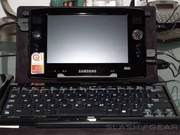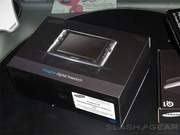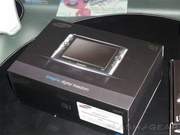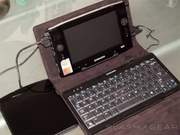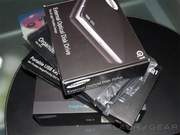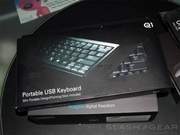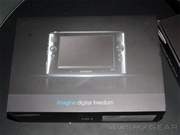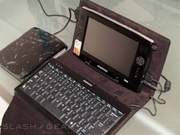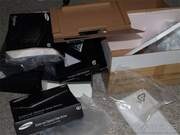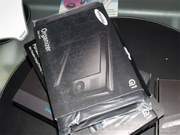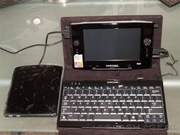Samsung Q1 UMPC And Accessories Reviewed
If we gently ease Apple into an out-of-mind drawer then it becomes fair to say that the award for most anticipated hardware of the year goes to the UMPC, March's Origami campaign for which persuaded some, at least momentarily, that Microsoft was hip. Since then, as first-gen models grace reviewers' hands, the mainstream computer press have been trying to find a use for them, while the loyal Tablet faithful have in most cases defended their existence. There comes a time when every reviewer must spurn the fence they sit upon and, with only a minor pause to pluck splinters from delicate places, decide whether a UMPC is something to heap cash or derision upon. Hence the Samsung Q1 in my slightly sweaty hands.
Arguably the poster-child for the whole UMPC concept, the Q1 is nevertheless typical of its breed. At casual glance it falls somewhere between high-end PDA and sub-notebook, far greater in functionality than the former but, by virtue of space and battery constraints, lacking the power of the latter. In theory it's a terrific idea, perhaps only hamstrung by technology not yet being there to realise the dream.
The Q1 features an Intel Celeron M ULV processor running at 900MHz, 256 MB of DDR2 RAM, a 7″ 800 x 480 touch screen, 40 GB HDD, Wi-Fi 802.11b/g, and Bluetooth, and is available through Best Buy and CDW only for $1,099. Sitting snugly in the hand, it's a comfortable beastie and demands little investment in operational style once stabbing bluntly at the touch-screen becomes habitual. Unlike the UMPCs older siblings, full-sized Tablet PCs, the Q1 and its ilk use passive touch-screens which will respond to any old pressure rather than specific styli. One can only assume that it's this fashionable promiscuity to touch that led Samsung to bundle the appalling standard stylus, which is an insult to both users and ergonomics in general.
[flv]https://www.slashgear.com/videos/q1umpc.flv[/flv]SlashGear unboxing the Samsung Q1
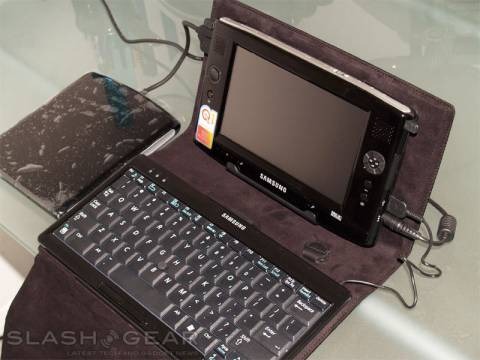
Most reviewers have spit the majority of their bile at the UMPCs lack of physical keyboard. Instead users have a variety of touchscreen-based methods. Aside from handwriting recognition, which can cope with a surprising degree of scrawl thanks to Microsoft's significant Tablet PC development, there's an on-screen QWERTY keyboard and DialKeys, a split keyboard laid out in two semicircles on the lower portions of both sides of the screen. The keyboard is a good idea, in theory, but the lack of tactile feedback made the device very difficult to get used to, at least for me. Also, if your aim isn't precise, you run the risk of hitting multiple keys at once; which throws off your whole typing stride. Samsung has a compact USB keyboard available as an accessory, but it effectively kills the portability advantage as now the Q1 works more like a traditional laptop than a UMPC.
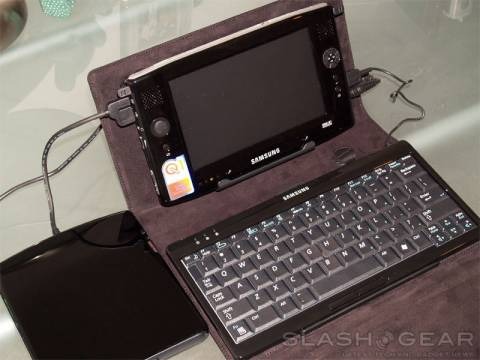
The Q1 has some other nifty features. Samsung had the foresight to include two USB 2.0 ports on the device, making connections to accessories and external devices easy. A full-sized VGA port on the side allows the device to be hooked up to projectors and external monitors, meaning that people who frequently use their computers for presentations aren't going to be left unsatisfied. While the screen is clear enough to watch movies and work with the simplest of documents, the low 800 x 480 resolution makes it difficult to do a lot of things that require more screen real estate, such as spreadsheets and the sort of tiny type you see on the bottom of contracts, NDAs and pre-nups. There's also a scroll button that allows you to scroll the screen horizontally and vertically, and the Q1 supports two "virtual" resolutions – 800 x 600 pixels and 1024 x 600 – which are simulated larger resolutions on the device's screen. The problem inherent here is the blurriness due to using a non-native resolution on the LCD screen, making the resolutions good for certain situations but overall too blurry to use all the time.
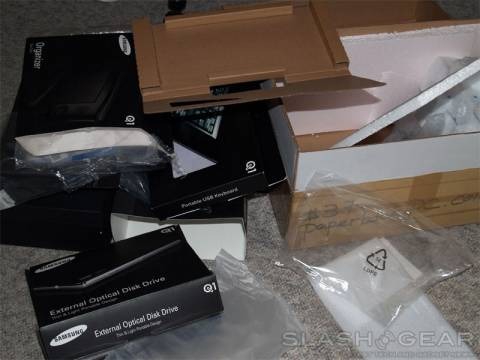
Finally, the Q1's specifications leave much to be desired. The 900MHz Celeron M ULV dawdles by today's standards, with noticeable lag in general use. The 40 GB hard drive is fair-sized so long as you don't plan on saving loads of music and movies to the hard drive; however, since the device comes without an optical drive – an external USB 2.0 one is available as an accessory – users will be forced to save movies to disk to watch them. The Q1's 512 MB of RAM is sufficient for most tasks, but can be upgraded. Battery life is average; the machine will run for 3 hours on minimum settings and around 1.5 hours when doing processor-intensive tasks, like video playback. Lastly, the price is a huge negative; for $1,099, users can now buy an Apple Macbook with 512 MB of RAM, a larger hard drive (60 GB), a larger screen (13" @ 1280x800), a physical keyboard, and Apple's trademark software (plus the ability to run Windows XP alongside OS X). Other PC notebooks offer better features than the Q1 for less money, making the Q1 a very difficult purchase to justify.
So, is the Q1 worth getting? Should you break open your precious piggy-bank and run, spilling coins from between your fingers, screaming "gimme gimme"? If you're looking for an extremely portable device capable of connecting worldwide, you might be better off with an expensive PDA Smartphone with a brace of wireless broadband capabilities. On the other hand, if you want a portable media center, the Q1 might just be up your alley. Power users will be put off by the skimpy specifications, but as a device that can watch movies, surf the Internet, write email, and chat online, the Q1 fits the bill perfectly. The counter-argument to many a poor review – and there really have been many – is that Microsoft's baby is designed for the queuing, striding, hyper-mobile corridor-warrior, someone for whom sitting down at a keyboard is perhaps only 10% of their day. It's a trendy image, yes, but can the battery life and mildly anaemic specs support such users? Overall, UMPCs – and the Q1 – hold a great deal of promise. We just might have to wait until the second generation – Q1b and third generations for them to live up to the hype...
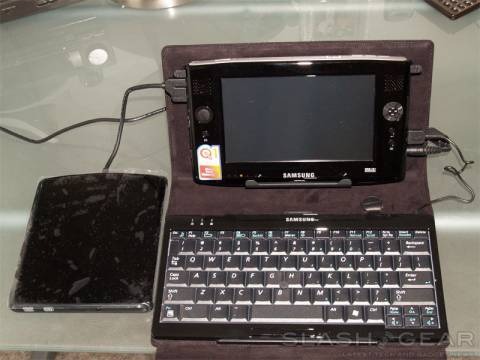
Achingly thin, and with a point-stick nestling warmly in its middle, the Samsung Portable Keyboard suffers the same shortcomings of all diminuished input devices; while it has a reasonable action and, thanks to the in-built mouse control, allows you to forgo the touchscreen for a more traditional laptop setup, it's cramped compared to standard keyboards. In situations where easy of portability takes priority that can be overlooked – a hotel room, perhaps, or a client's office – but you would probably start to notice the agonising wrist pain with regular use. And while Samsung would have you believe you can have the best of tablet and laptop worlds, the lack of structural connection between Q1 and keyboard means using the pair on an aeroplane table would be difficult if not impossible, particularly if you're hearded into the cheap seats like tech-enabled cattle. Some marks have to be deducted for the USB connection, too, with Bluetooth being the fashionable interface these days.
Styled similarly to the Q1, Samsung's external optical drive is pretty straightforward. Handy for installing applications and speedy in use, in of itself it's a nice addition to the package. On a practical note, however, given that the UMPC is really meant to be a companion PC to your desktop, you could really save yourself the money and share the desktop's DVD drive over the network for those moments when you really have to use physical media.
Somewhere when you really wouldn't want to save money is protecting your precious UMPC from the bangs and scuffles of the big scary world. Unless you've got the insurance policy and/or bank account of Donald Trump, you're going to want a case of some description. The official Samsung Portfolio Case allows you to fasten your Q1 and keyboard inside and makes using it as a laptop replacement somewhat easier. However, it adds bulk and isn't especially handy for use when standing or walking, so the corridor warrior will probably want to look elsewhere.
